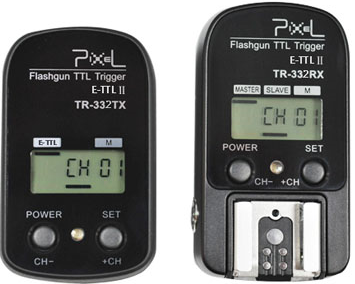Set fire at a distance
Still, there is justice in the world, and soon the dreams of strobe artists from around the world will come true - after RadioPopper and PocketWizard, full radio synchronizers began to be produced in China (more precisely, in Hong Kong, which has recently become its province. If you used radio synchronizers, I’ve probably seen offers from Chinese Cactus , and even from Russian Search-photos , but they don’t have the most important thing - TTL support, for which many photographers are ready to sell their souls (more precisely, give 400-450 dollars for a RadioPopper or PocketWizard kit).

Manual ignition is also good, but in the studio, but TTL is needed if you are shooting on the beach under the clouds, and the flash is on a stand at 30 meters - while the camera itself informs the flash, how much power to click, giving a preliminary impulse for evaluation. It is just inconvenient to run back and forth to change the power of the puff to the level.
')
The Hong Kong company Pixel produces sync cables, conventional radio synchronizers, remote control systems. Now she announced the launch of a remote ignition system with TTL support on the market this year, not with reading the flash pulse, but in which the transmitter fully clings to the “shoe” of the camera, and the receiver has a “shoe” for connecting the flash - exactly the same as the latest generation of RadioPopper and PocketWizard. While the information on the product is scarce, it is clear only that the company is launching a version for Canon (TR-332, with E-TTL II support) by the new year, and for Nikon (TR-331) a little later.

The most pleasant thing about the announcement is that the price of the bundle will be about $ 200, which is why the strobists all over the world are rejoicing, but for us it’s nice that China is much closer to taking goods than from America. True, it must be remembered that these are purely Chinese products, which are always associated with not very good quality. In addition, flash control systems are considered to be almost the most closed function in cameras - even the Japanese Sigma still has many problems in controlling the light pulse, not to mention the direct signal transmission. New versions of radio synchronizers of even Western production had a lot of complaints in terms of quality of work, which, apparently, were quickly eliminated and debugged.

Manual ignition is also good, but in the studio, but TTL is needed if you are shooting on the beach under the clouds, and the flash is on a stand at 30 meters - while the camera itself informs the flash, how much power to click, giving a preliminary impulse for evaluation. It is just inconvenient to run back and forth to change the power of the puff to the level.
')
The Hong Kong company Pixel produces sync cables, conventional radio synchronizers, remote control systems. Now she announced the launch of a remote ignition system with TTL support on the market this year, not with reading the flash pulse, but in which the transmitter fully clings to the “shoe” of the camera, and the receiver has a “shoe” for connecting the flash - exactly the same as the latest generation of RadioPopper and PocketWizard. While the information on the product is scarce, it is clear only that the company is launching a version for Canon (TR-332, with E-TTL II support) by the new year, and for Nikon (TR-331) a little later.

The most pleasant thing about the announcement is that the price of the bundle will be about $ 200, which is why the strobists all over the world are rejoicing, but for us it’s nice that China is much closer to taking goods than from America. True, it must be remembered that these are purely Chinese products, which are always associated with not very good quality. In addition, flash control systems are considered to be almost the most closed function in cameras - even the Japanese Sigma still has many problems in controlling the light pulse, not to mention the direct signal transmission. New versions of radio synchronizers of even Western production had a lot of complaints in terms of quality of work, which, apparently, were quickly eliminated and debugged.
Source: https://habr.com/ru/post/76185/
All Articles